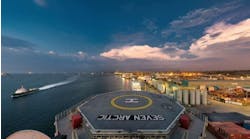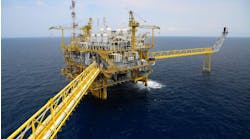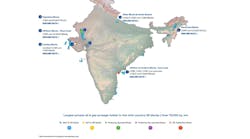William Furlow
Senior Editor
While the US Department of Energy's "Offshore Technology Roadmap"for the ultra-deepwater Gulf of Mexico is a positive step to better understand the needs of the industry, the tangible benefits of this report are not yet clear. The goal is straightforward. The US government would like to see the Gulf of Mexico become a low cost producer to offset the country's dependence on foreign oil. Any undiscovered reserves large enough to have such a huge economic impact lie in ultra-deepwater. Given this assumption, the 72-page DOE study examines the technologies needed to identify and produce these reserves.
The report was produced from workshops the DOE held with industry leaders and academics, as well as government sources. The report lists a variety of key strategies and supporting technologies that must be developed to produce ultra-deepwater reserves at a competitive cost.
Under the roadmap, the development of the new technologies required for ultra-deepwater E&P are divided into categories, and these are subjected to a timeline that uses a design approach to promising fasttrack technology. High intensity design using computer technology and clearly identified goals help streamline a design, which should save money and speed innovation.
These designs are produced on an open-system basis, so those working on related systems can be involved in decisions by other teams that may affect their part of the design. The goal is to have an optimized design with component systems that can be added to the design, so the best possible solution for each challenge is incorporated.
The goal is to use new system architecture and a high-intensity design engine to develop a virtual prototype that includes the best solutions for every system in an integrated design. The subsystems of this holistic "reservoir development design system" are the different subsystems needed to find and produce oil and gas.
These include drilling systems, artificial lift, subsea separation, intervention, and others. The idea is to organize everything at a big-picture level, then attack the individual problems with an eye toward how changes in one system affect others.
Under this new approach, the technologies have been divided into familiar categories, with familiar limitations.
Accelerated exploration
The first category is "Accelerated Reservoir Explor-ation." It should be no great surprise that the roadmap focuses on increasing certainty and speed in seismic exploration and enhanced reservoir management efficiency.
This involves reservoir property verification through direct measurement of the properties of the reservoir rock and fluids. Using a subsea gathering system, which involves a network of underground wells rather than individual wells, would be a way to improve recovery, and reservoir monitoring and control. Sensors would give real-time data to better understand and manage an asset.
Rigs, reach, riserless
The category of "Rigs, Reach, Riserless" acknowledges that just beefing up shallow water systems is not an effective way to drill and produce ultra-deepwater wells. The focus here is on remote operations and robotics. Specific technologies highlighted include riserless drilling.
This goes beyond the systems currently under assessment that have no riser, but do involve a drilling fluids return line. System integration while drilling is a concept that uses software and tools that allow the "drainage architecture" for wells to be modularly constructed while drilling is underway.
Under this same category is a discussion of high capacity production wells. These wells can increase production rates, but there are questions of wellbore stability while drilling and the reliability of the tubulars under such high rates of production. Of course, intervention systems will be a major consideration in ultra-deepwater and the roadmap looks at autonomous underwater vehicles (AUV) and robotics as novel solutions to remotely accessing these wells.
Energy to market
"Energy to Market" is the last piece of the puzzle. Here, the roadmap looks at the promising areas of subsea processing and flow assurance. The two could go hand-in-hand. If it is possible to remove water from gas production downhole, for example, it could drastically reduce the threat of hydrate formation.
Another area that is gaining attention is the need for cleaner feedstocks. The goal here is to refine production to clean levels as early in the energy chain as possible to reduce the cost and slowdowns associated with transporting these "non-value adding" components to the beach.
There was also discussion of offshore power generation and transmission. The goal here is to develop a safe and efficient way to generate electricity offshore, re-inject the exhaust gas, and send the power to shore. The key to this would be the development of superconducting cables that could carry the power to different locations onshore. Of course, the obvious question is: Would this be cheaper after the cost of building a power plant offshore and laying the necessary high-power lines?
There was also discussion of environmental issues in ultra-deepwater. Specifically, the goal would be to capture a "spill" while it is below the surface, rather that containing it on the surface. There are associated well-control issues at great depths that also will have to be addressed.
The next step
In remarks before the Deepwater Subsea Tieback Forum (Feb. 6-8, 2001 in Galveston, Texas), Betty Filber with the DOE said the government's goal is to encourage industry-driven research. The DOE is eager for the roadmap to grow into an offshore development program.
The program development meeting for the roadmap identified two sets of priorities - strategic issues and technology issues - faced by the industry. The next step in the process is to meet and prioritize the technology issues listed above. Filber said this meeting needs to occur soon.




